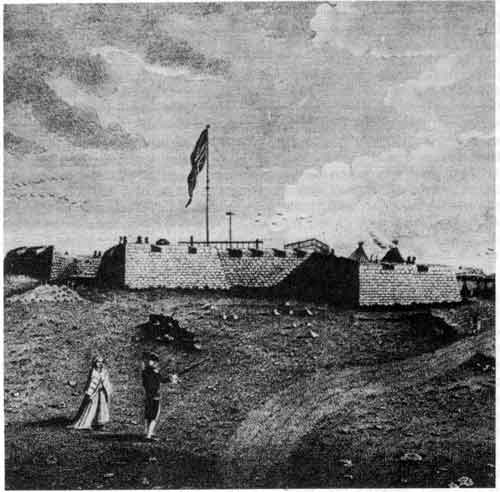Today, I woke up early to go to the Prince of Wales Fort to help LeeAnn fix some of the data loggers that didn't seem to be collecting any data any more. I had two things to bring, my laptop and a USB to serial wire. I forgot the wire, making the laptop useless for connecting to the loggers. I have to be more careful about making sure I bring what I need. Luckily, LeeAnn had a backup method, but I felt pretty foolish.
So what is the Prince of Wales Fort?
Having walked through this fort with big stone walls, I have no idea how they survived the winter.
"As one post governor reported in 1741, the fort's living quarters were '... very cold, freezing everything in the cabin, though a fire kept in from five in the morning till nine at night; and when the fire is out, a red hot shot, twenty-four pounds weight (a cannon ball) hung up at the window to thaw it; on the outside there are shutters to every window, six inches thick; four large fires made in the stoves every day - a cartload of wood for each; yet all this will not keep things from freezing within doors.'" (From Parks Canada)
The treeline on the same side of the river as the fort is greatly depressed in comparison to the other side of the river. Why? Well, to feed those "four large fires made in the stoves everyday - a cartload of wood for each." That's a lot of wood anywhere, but especially in a place that gets to -50/-60 C regularly in the winter. This is yet another fine example of how people do not take advantage of the environment around them. Put another way, this is another fine example of how Europeans tried to implement something that might work back in Europe where it is comparably warm in a new environment where the resources aren't there and you simply can't live the same way.
What did the inuit do to survive the cold? They built snowhouses, igluvijaq, that used the snow as insulation. The design used the resources available in the immediate environment so well that just by sitting in one, you could raise the temperature in a house between -7 C to 15 C when it is -50 C outside, just with body heat.
Innovations like this, built off of the environment itself, using the physics and traditions of a culture, make sustainability. Sustainability is unique to every region. From the structure of buildings to eating food that is is found in the region, such as caribou and other bushmeat up here. When will we learn this lesson?
Side note, there was also a polar bear about 200 m from the fort, far enough away not to bother us, but the bear monitor kept a close eye on him. That makes 7 polar bears. That's enough that I no longer feel the urge to take a picture of a little white dot on rocks. So I'm sorry, but no picture of a polar bear today.
The other note I would like to make is that today was 28 C. The hottest it has gotten here today. Being in a bug jacket and long pants in 28 C is torture! I came to Churchill to escape the heat of southern summer. But we fixed that by jumping into Stigge Creek.
 |
| Introducing the swimming gang: Brit, Krista, Celia, LeeAnn, Carley, Trigger and Dez (Carley's dogs), and me |
 |
| That's me with Trigger! It was really nice to swim without worrying about fish or crayfish or any other critters sneaking up to you and nibbling your feet! |






No comments:
Post a Comment